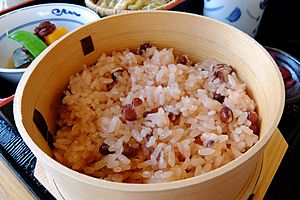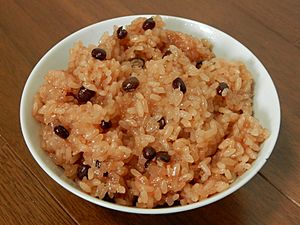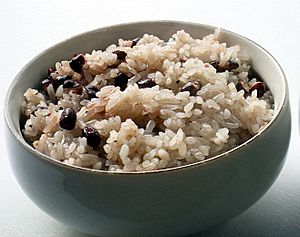Red bean rice facts for kids
 |
|
| Region or state | East Asia |
|---|---|
| Associated national cuisine | Chinese Japanese Korean |
| Main ingredients | Rice, adzuki beans |
| Similar dishes | Kongbap |
Red bean rice is a special dish from East Asia. It's made by cooking rice with adzuki beans, which are small red beans.
This tasty dish has different names depending on the country. In Korean, it's called patbap (팥밥). In Japanese, it's known as sekihan (赤飯). And in Chinese, it's called hóngdòu fàn (红豆饭).
Contents
Red Bean Rice Around East Asia
Red bean rice is a popular and important dish in many parts of East Asia. It's often eaten during special times or holidays. Let's explore how it's enjoyed in different countries.
Red Bean Rice in China
Hóngdòu fàn (红豆饭) is a traditional Chinese dish. You can find it in some areas of China, especially in Jiangsu province. People there often eat it on a day called Winter Clothes Day.
The Shepherd Boy Story
There's a touching story from the Dafeng area of Yancheng, Jiangsu, about why people eat red bean rice. Long ago, a kind shepherd boy from a poor family worked for a landlord. One day, some sheep he was watching fell into a valley and died. The landlord was very angry and treated the boy badly. Sadly, the boy passed away because of the landlord's anger.
The story says that the red color of the beans mixed with rice reminds people of this sad event. This happened on the first day of October. So, eating hóngdòu fàn on Winter Clothes Day helps people remember the shepherd boy.
A Special Meal
In 2015, hóngdòu fàn was served at a very important dinner. It was part of a state banquet for the Indian president, Narendra Modi, when he visited Chinese president, Xi Jinping, in Xi'an, Shaanxi province. This shows how special the dish is!
Red Bean Rice in Japan
Sekihan (赤飯) is a traditional Japanese dish. Its name means "red rice." It's made by steaming sticky rice with adzuki beans. The beans give the rice a beautiful reddish color.
Why Red Rice?
A long time ago in Japan, the rice itself was naturally red. This red rice was used in special religious ceremonies. Over time, people stopped growing this old red rice. Now, sekihan gets its red color from the adzuki beans.
For Happy Occasions
Sekihan is often served during happy events in Japan. You'll find it at birthdays, weddings, and holidays like Shichi-Go-San. It's so connected to celebrations that if someone says, "Let's have sekihan!", it means "Let's celebrate!" The red color is a symbol of happiness in Japan.
How to Enjoy Sekihan
People usually eat sekihan right after it's cooked. But it's also delicious at room temperature, often packed in a celebratory bento (a boxed lunch). It's traditionally eaten with gomashio, which is a mix of lightly toasted sesame seeds and salt.
Regional Differences
There are different ways to make sekihan in various parts of Japan. Some recipes use sugar instead of salt, making the dish sweet. Others might use amanattō (a sweet bean candy) instead of adzuki beans. Many people also use sasage (ササゲ, a type of black cowpea bean) instead of adzuki beans.
Red Bean Rice in Korea
Patbap (팥밥) is a Korean dish made with non-glutinous white short-grain rice and adzuki beans. It's a type of bap, which means a cooked grain dish.
History and Tradition
Patbap has been mentioned in old Korean cookbooks, like Joseon Mussangsinsik Yorijaebeop. It's a traditional recipe from Pyongan Province, where many adzuki beans are grown. In Korea, patbap is often eaten in the winter. It's also prepared for holidays and birthdays, which is why it's sometimes called "birthday rice."
How Patbap is Made
Making patbap is similar to making regular white rice. The main difference is that cooked whole adzuki beans are mixed with the rice before boiling. If the beans are fresh and not dried, they don't need to be boiled beforehand. A common ratio is four parts rice to one part adzuki beans, but you can adjust it to your taste.
Different Kinds of Patbap
- Patbap (팥밥): Adzuki beans are boiled until they are cooked but still whole. Then, they are mixed with rice that has been soaked in water. The mixture is boiled again, often using some of the water the beans were boiled in.
- Budungpat-bap (부둥팥밥): Budung-pat means fresh beans. Ripe, fresh adzuki beans are mixed directly with soaked rice and then boiled. Since fresh beans have moisture, less water is needed.
- Geopipat-bap (거피팥밥): Geopi-pat means husked beans. Red or black adzuki beans are husked (their outer skin removed) and ground. This ground bean mixture is then added to soaked rice. Husked adzuki beans are a creamy white color.
- Jungdung-bap (중둥밥): Whole adzuki beans are boiled, and the water is strained out to make reddish rice. The boiled red beans can be sweetened and used in desserts. If barley is added, it's called pat-bori-bap (팥보리밥), meaning "adzuki bean and barley rice." In Gangwon Province, a dish with corn kernels instead of rice, mixed with adzuki beans, is called oksusu-pat-bap (옥수수팥밥), or "corn and adzuki bean rice."



